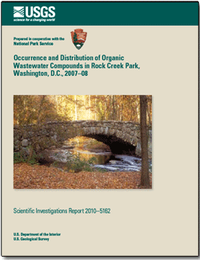The U.S. Geological Survey, and the National Park Service Police Aviation Group, conducted a high-resolution, low-altitude aerial thermal infrared survey of the Washington, D.C. section of Rock Creek Basin within the Park boundaries to identify specific locations where warm water was discharging from seeps or pipes to the creek. Twenty-three stream sites in Rock Creek Park were selected based on the thermal infrared images. Sites were sampled during the summers of 2007 and 2008 for the analysis of organic wastewater compounds to verify potential sources of sewage and other anthropogenic wastewater. Two sets of stormwater samples were collected, on June 27-28 and September 6, 2008, at the Rock Creek at Joyce Road water-quality station using an automated sampler that began sampling when a specified stage threshold value was exceeded. Passive-sampler devices that accumulate organic chemicals over the duration of deployment were placed in July 2008 at the five locations that had the greatest number of detections of organic wastewater compounds from the June 2007 base-flow sampling. During the 2007 base-flow synoptic sampling, there were ubiquitous low-level detections of dissolved organic wastewater indicator compounds such as DEET, caffeine, HHCB, and organophosphate flame retardants at more than half of the 23 sites sampled in Rock Creek Park. Concentrations of DEET and caffeine in the tributaries to Rock Creek were variable, but in the main stem of Rock Creek, the concentrations were constant throughout the length of the creek, which likely reflects a distributed source. Organophosphate flame retardants in the main stem of Rock Creek were detected at estimated concentrations of 0.2 micrograms per liter or less, and generally did not increase with distance downstream. Overall, concentrations of most wastewater indicators in whole-water samples in the Park were similar to the concentrations found at the upstream sampling station at the Maryland/District of Columbia boundary. Polycyclic aromatic hydrocarbons were the dominant organic compounds found in the stormwater samples at the Joyce Road station. Polycyclic aromatic hydrocarbons were consistently found in higher concentrations either in sediment or in whole-water samples than in the dissolved samples collected during base-flow conditions at the 23 synoptic sites, or in the Joyce Road station stormwater samples.


